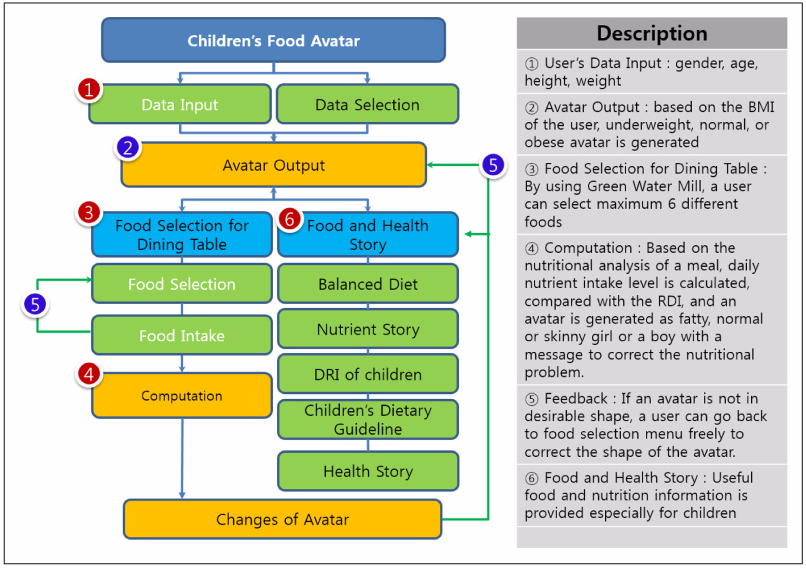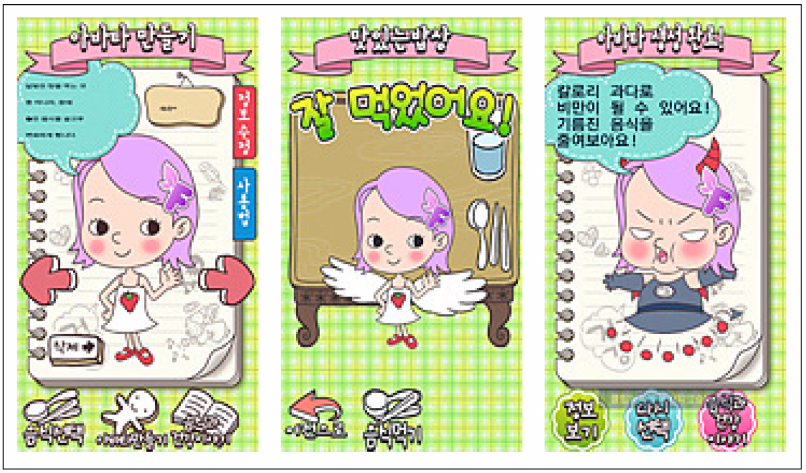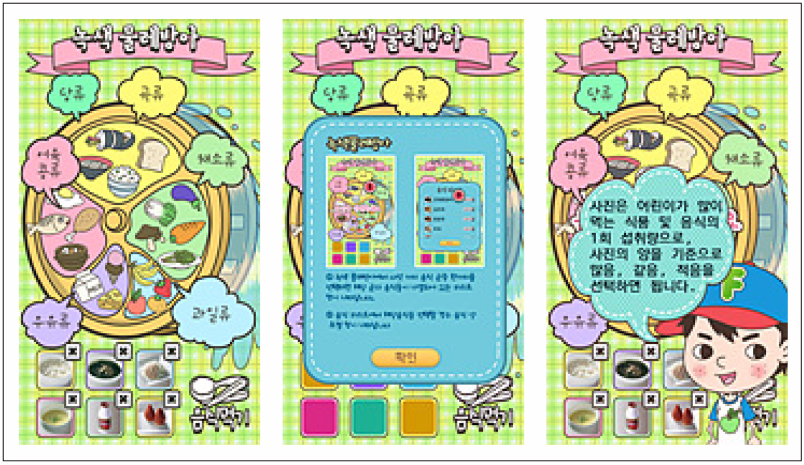Korean J Community Nutr.
2013 Aug;18(4):299-311. 10.5720/kjcn.2013.18.4.299.
Development of 'Children's Food Avatar' Application for Dietary Education
- Affiliations
-
- 1Major of Elementary Science & Technology Education for Life, Graduate School of Seoul National University of Education, Seoul, Korea.
- 2Department of Food Science & Human Nutrition, Chonbuk National University, Jeonju, Korea.
- 3Department of Food Sciences & Nutrition, Soonchunhyang University, Asan, Korea.
- 4Department of Food and Nutrition, Kangwon National University, Samcheok, Korea.
- 5Department of Computer Education, Seoul National University of Education, Seoul, Korea.
- 6Department of Agrofood Resources, National Academy of Agricultural Sciences, RDA, Suwon, Korea.
- 7Department of Science & Technology Education for Life, Seoul National University of Education, Seoul, Korea. kimjwe@snue.ac.kr
- KMID: 2267525
- DOI: http://doi.org/10.5720/kjcn.2013.18.4.299
Abstract
- An educational application (App) called 'Children's Food Avatar' was developed in this study by using a food DB of nutrition and functionality from Rural Development Administration (RDA) as a smart-learning mobile device for elementary school students. This App was designed for the development of children's desirable dietary habits through an on-line activity of food choices for a meal from food DB of RDA provided as Green Water Mill guide. A customized avatar system was introduced as an element of fun and interactive animation for children which provides nutritional evaluation of selected foods by changing its appearance, facial look, and speech balloon, and consequently providing chances of correcting their food choices for balanced diet. In addition, nutrition information menu was included in the App to help children understand various nutrients, their function and healthy dietary life. When the App was applied to 54 elementary school students for a week in November, 2012, significant increases in the levels of knowledge, attitude and behavior in their diet were observed compared with those of the control group (p < 0.05, 0.01). Both elementary students and teachers showed high levels of satisfaction ranging from 4.30 to 4.89 for the App, therefore, it could be widely used for the dietary education for elementary school students as a smart-learning device.
Figure
Cited by 2 articles
-
Effects of Nutrition Education Using Dietary Guidebook in Higher Grade Elementary Students of Jeonbuk Area
Mi-Ran Park, Sook-Bae Kim
Korean J Community Nutr. 2018;23(1):13-27. doi: 10.5720/kjcn.2018.23.1.13.A Qualitative Study on the Potential Utilization of a Mobile Phone for Obesity Management in Elementary-School Children : Parents Perspective
Bo Young Lee, Mi-Young Park, Kirang Kim, Jea Eun Shim, Ji-Yun Hwang
Korean J Community Nutr. 2019;24(2):117-126. doi: 10.5720/kjcn.2019.24.2.117.
Reference
-
1. Choi MK, Lee HS, Kim SB, Kim SN, Kim SY. Establishment of one portion size of foods frequently consumed by Korean children aged 6-11 using 2005 Korea national health and nutrition examination survey and its comparison with adults. Korean J Community Nutr. 2010; 15(5):625–635.2. Choi SY. The difference in eating habits and food preference of elemantary school students residing in two different areas and the need of nutrition education. Nutrition Education Major Dept. of Nutrition Education Graduate School of Education Sungshin Women's University;2011. p. 24.3. Encyber. Definition of avatar. 2012. cited 2012 Fabruary 14. http://www.doopedia.co.kr.4. EatRight. Daily food log and food group checklist. 2012. cited 2012 Fabruary 14. http://slidetorock.com/apps/EatRight-daily-food-diary.html.5. Fooducate. Scan & choose health groceries. 2012. cited 2012 Fabruary 14. http://www.fooducate.com.6. Food Scanner. Calorie counter, BMI-calculator. 2012. cited 2012 Fabruary 14.7. KFDA. Comic books and animation as dietary education materials for children. 2012. cited 2012 Fabruary 14. Available from http://www.kfda.go.kr/nutrition/index.do?nMenuCode=33.8. Kim AY. A study on the dietary pattern of upper grades of elementary school children to develop a food & nutrition education program based on practical arts subject. Daejon, Korea: Department of Nutrition Education, Graduate School of Education, Paichai University;2012. p. 1–2.9. Kim BK, Park HR, Kim JW. Development of comic books and an animation as dietary education materials for children. Korean J Community Nutr. 2008; 13(5):630–639.10. Kim HS. The relation between avatar playing and appearance management behavior of the elementary school students. Gyeongin National University of Education;2011. 5–6. MS thesis.11. Kim HY, Kim JW. Development and application of food safety education textbook on agri-food for creative activities of 2009 revised curriculum. J Korean Pract Arts Educ. 2011; 24(3):255–279.12. Kim JW. Analysis of food and dietary education in the 7th primary school curriculum as a science & technology for life. J Korean Pract Arts Educ. 2005; 18(1):129–144.13. Kim JW, Hyon SM. Improvement of dietary attitudes of elementary students by nutrition labeling education. Korean J Community Nutr. 2007; 12(2):168–177.14. Kim , MJ , Kim KW, Seo JS, Lee YM, Oh YJ, Ahn HS, Kim JH, Kim JW, Park HR, Kim SH, Park HK. Development of a webbased food selection program for children's nutrition education. Comp Rev Korean Soc Food Sci Nutr;2008. p. 2–13.15. Kim SB. Development of new functional agricultural food and value-added technology. National Academy of Agricultural Science;2011. p. 4–6.16. Korea Center for Disease Control. Korea standard growth chart of children and adolescent. Seoul: Ministry of Health & Welfare;2007.17. Korea Communications Commission. Statistics of wire and wireless users in Korea. 2012. cited 2012 August 10. Available from http://www.kcc.go.kr.18. Korean Nutrition Society. Dietary reference intakes for Koreans, first revision. Seoul: Korean Nutrition Society;2010.19. Lee HJ. Smart phone based Chinese education Application project and production experiment. Ewha Womans University;2011. 9–10. MS thesis.20. Lee YM, Shim JE, Yoon JH. Change of children's meal structure in terms of temporal and spatial dimensions: analysis of the data from the Korea national health and nutrition examination surveys of 1998 and 2009. Korean J Community Nutr. 2012; 17(1):109–118.21. Lim JH, Lee HJ, Kim JW. Development of children's obesity prevention program by using 'Health Diary'. J Korean Pract Arts Educ. 2009; 15(4):281–300.22. Ministry of Health & Welfare. Health diary. 2012. cited 2012 February 14. Available from http://diary.hp.go.kr.23. MOHW. KCDC. Korea National Health and Nutrition Examination Survey (KNHANES IV-3). Korea health statistics 2009. 2011.24. Rothwell WJ, Cookson PS. Beyond instruction : comprehensive program planning for business and education. San Francisco, Calif: Jossey-Bass Publishers;1997.25. Rural Development Administration. Nutrition guide for my children. Paju: Kyomunsa;2010.26. Whole Kids Foundattion. Children's nutrition and wellness. 2012. cited 2012 Fabruary 14. Available from http://www.wholekidsfoundation.org.
- Full Text Links
- Actions
-
Cited
- CITED
-
- Close
- Share
- Similar articles
-
- Study on the Correlation Between the Dietary Habits of Mothers and Their Preschoolers and the Mother's Need for Nutritional Education for Preschoolers
- Application of a Practical Nutrition Education Program, KHIDIKIDS, for the Improvement of Dietary Attitudes and Habits of Elementary Students
- A Study on Dietary Habits, Dietary Behaviors and Body Image Recognition of Nutrition Knowledge after Nutrition Education for Obese Children in Seoul
- Effects of Nutrition Education on Nutrition Knowledge, Dietary Attitudes, and Food Behavior of College Students
- Development and Application of Dietary Education to Improve the Vegetable Intake of Preschoolers





